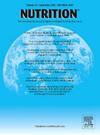Association of node assortativity and internalizing symptoms with ketogenic diet effectiveness in pediatric patients with drug-resistant epilepsy
IF 3.2
3区 医学
Q2 NUTRITION & DIETETICS
引用次数: 0
Abstract
Background
The ketogenic diet (KD) is an effective alternative therapy for drug-resistant epilepsy (DRE). However, there are no established predictors for KD effectiveness. We aimed to investigate the impact of 12 months of KD therapy (KDT) on brain connectivity, as measured by functional magnetic resonance imaging (fMRI), and its correlation with seizure control, behavioral/mood alterations, and parental stress.
Methods
Children with DRE were enrolled in this single-center, prospective cohort study from February 2020 to October 2021. They were divided into a control group and a KDT group. The Child Behavior Checklist (CBCL) and Parental Stress Index (PSI) were administered to parents at the initiation of KDT (T0) and at 12 months (T1). Resting-state fMRI was performed at T0 and at 6 months of KDT. The primary outcome was the between-group difference in the change of CBCL/PSI scores, and brain connectivity metrics after KDT, and the secondary outcome involved measuring their correlation with seizure reduction rates.
Results
Twenty-two patients with DRE were enrolled. We had 13 patients in the control group and 9 in the KDT group. Our data revealed that 12 months of KDT can reduce monthly seizure frequency. Several subscales of CBCL T-scores were higher at T0 compared with the control group, then becoming comparable at T1. The PSI scores from ’mothers’ reports reduced after receiving KDT. The changes in node assortativity (ΔAssortativity) were positively correlated with behavioral problems and negatively with seizure reduction rates in the KD group.
Conclusions
Twelve months of KDT can reduce monthly seizure frequency and improve mood/behavioral disturbances in patients with DRE. Furthermore, KDT could relieve primary caregivers’ stress. A lower ΔAssortativity value was associated with better behavioral outcomes and greater seizure reduction. The ΔAssortativity value in fMRI may be a crucial predictor for the effectiveness of KDT.
小儿耐药癫痫患者的结配性和内化症状与生酮饮食效果的关系
生酮饮食(KD)是治疗耐药癫痫(DRE)的有效替代疗法。然而,目前还没有确定的KD有效性预测指标。我们的目的是研究12个月的KD治疗(KDT)对脑连通性的影响,通过功能磁共振成像(fMRI)测量,以及它与癫痫发作控制、行为/情绪改变和父母压力的相关性。方法2020年2月至2021年10月,DRE患儿被纳入这项单中心前瞻性队列研究。将患者分为对照组和KDT组。在KDT开始(T0)和12个月(T1)时对父母进行儿童行为检查表(CBCL)和父母压力指数(PSI)。静息状态fMRI分别在KDT的第0和第6个月进行。主要结果是KDT后CBCL/PSI评分和脑连通性指标变化的组间差异,次要结果包括测量它们与癫痫发作减少率的相关性。结果共纳入22例DRE患者。对照组13例,KDT组9例。我们的数据显示,12个月的KDT可以减少每月癫痫发作的频率。与对照组相比,CBCL t评分的几个分量表在T0时较高,然后在T1时具有可比性。接受KDT后,“母亲”报告中的PSI得分有所下降。在KD组中,节点匹配性(ΔAssortativity)的变化与行为问题呈正相关,与癫痫发作减少率呈负相关。结论12个月的KDT治疗可降低DRE患者的月发作频率,改善患者的情绪/行为障碍。此外,KDT可以缓解主要照顾者的压力。较低的ΔAssortativity值与更好的行为结果和更大的癫痫发作减少相关。功能磁共振成像的ΔAssortativity值可能是KDT有效性的关键预测因子。
本文章由计算机程序翻译,如有差异,请以英文原文为准。
求助全文
约1分钟内获得全文
求助全文
来源期刊

Nutrition
医学-营养学
CiteScore
7.80
自引率
2.30%
发文量
300
审稿时长
60 days
期刊介绍:
Nutrition has an open access mirror journal Nutrition: X, sharing the same aims and scope, editorial team, submission system and rigorous peer review.
Founded by Michael M. Meguid in the early 1980''s, Nutrition presents advances in nutrition research and science, informs its readers on new and advancing technologies and data in clinical nutrition practice, encourages the application of outcomes research and meta-analyses to problems in patient-related nutrition; and seeks to help clarify and set the research, policy and practice agenda for nutrition science to enhance human well-being in the years ahead.
 求助内容:
求助内容: 应助结果提醒方式:
应助结果提醒方式:


